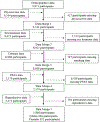Perfluoroalkyl and Polyfluoroalkyl substance exposure and association with sex hormone concentrations: Results from the NHANES 2015-2016
- PMID: 36061407
- PMCID: PMC9440377
- DOI: 10.1186/s12302-021-00508-9
Perfluoroalkyl and Polyfluoroalkyl substance exposure and association with sex hormone concentrations: Results from the NHANES 2015-2016
Abstract
Background: There is increasing global concern regarding the health impacts of perfluoroalkyl and polyfluoroalkyl substances (PFAS), which are emerging environmental endocrine disruptors. Results from previous epidemiological studies on the associations between PFAS exposure and sex hormone levels are inconsistent.
Objective: We examined the associations between serum PFAS compounds (PFDeA, PFHxS, PFNA, PFOA, PFOS) and sex hormones, including total testosterone (TT), free testosterone (FT), estrogen (E), and serum hormone binding globulin (SHBG).
Results: After adjusting for potential confounders, PFDeA, PFOS, and PFHxS exposures were significantly associated with increased serum testosterone concentrations in males. PFDeA, PFOA, and PFOS exposures were positively correlated with FT levels in 20-49 years old women while PFOS exposure was negatively associated with TT levels in 12-19 years old girls. PFAS exposure was negatively associated with estradiol levels including: PFDeA in all females, PFHxS, PFNA, PFOS, and PFOA in 12-19 years old girls, PFNA in women above 50 years old, and PFOA in 12-19 years old boys while PFDeA and PFOS exposures were positively associated with estradiol levels in these boys. n-PFOS exposure was positively associated with SHBG levels in men older than 20 and in all females.
Conclusions: Using a large cohort of males and females aged from 12-80, we found that PFAS exposure appears to disrupt sex hormones in a gender-, age-, and compound-specific manner. Future work is warranted to clarify the causality and mechanisms involved.
Keywords: NHANES; PFAS; SHGB; estradiol; testosterone.
Conflict of interest statement
Competing interests The authors report no conflicts of interest.
Similar articles
-
Perfluoroalkyl substances and sex hormones in postmenopausal women: NHANES 2013-2016.Environ Int. 2021 Apr;149:106408. doi: 10.1016/j.envint.2021.106408. Epub 2021 Feb 3. Environ Int. 2021. PMID: 33548847
-
Per- and polyfluoroalkyl substances (PFAS), thyroid hormones, sexual hormones and pubertal development in adolescents residing in the neighborhood of a 3M factory.Environ Health. 2025 Jun 7;24(1):34. doi: 10.1186/s12940-025-01188-1. Environ Health. 2025. PMID: 40483423 Free PMC article.
-
Higher PFOS exposure associated with higher SHBG in third trimester. The Odense Child Cohort.Environ Res. 2025 Jun 1;274:121265. doi: 10.1016/j.envres.2025.121265. Epub 2025 Feb 28. Environ Res. 2025. PMID: 40024504
-
Per- and Polyfluoroalkyl Substances and Breastfeeding as a Vulnerable Function: A Systematic Review of Epidemiological Studies.Toxics. 2023 Mar 29;11(4):325. doi: 10.3390/toxics11040325. Toxics. 2023. PMID: 37112552 Free PMC article. Review.
-
A Scoping Assessment of Implemented Toxicokinetic Models of Per- and Polyfluoro-Alkyl Substances, with a Focus on One-Compartment Models.Toxics. 2023 Feb 9;11(2):163. doi: 10.3390/toxics11020163. Toxics. 2023. PMID: 36851038 Free PMC article. Review.
Cited by
-
Associations of prenatal and postnatal exposure to perfluoroalkyl substances with pubertal development and reproductive hormones in females and males: The HOME study.Sci Total Environ. 2023 Sep 10;890:164353. doi: 10.1016/j.scitotenv.2023.164353. Epub 2023 May 22. Sci Total Environ. 2023. PMID: 37225096 Free PMC article.
-
The long-chain polyfluorinated alkyl substance perfluorohexane sulfonate (PFHxS) promotes bone marrow adipogenesis.Toxicol Appl Pharmacol. 2024 Oct;491:117047. doi: 10.1016/j.taap.2024.117047. Epub 2024 Aug 5. Toxicol Appl Pharmacol. 2024. PMID: 39111555 Free PMC article.
-
Perfluorooctane sulfonic acid modulates expression of placental steroidogenesis-associated genes and hormone levels in pregnant rats.Reprod Toxicol. 2023 Jun;118:108390. doi: 10.1016/j.reprotox.2023.108390. Epub 2023 May 4. Reprod Toxicol. 2023. PMID: 37148813 Free PMC article.
-
Environmental Exposure to Per- and Polyfluorylalkyl Substances (PFASs) and Reproductive Outcomes in the General Population: A Systematic Review of Epidemiological Studies.Int J Environ Res Public Health. 2024 Dec 2;21(12):1615. doi: 10.3390/ijerph21121615. Int J Environ Res Public Health. 2024. PMID: 39767456 Free PMC article.
-
Epigenetic Consequences of In Utero PFAS Exposure: Implications for Development and Long-Term Health.Int J Environ Res Public Health. 2025 Jun 10;22(6):917. doi: 10.3390/ijerph22060917. Int J Environ Res Public Health. 2025. PMID: 40566344 Free PMC article. Review.
References
-
- Bach CC, Vested A, Jorgensen KT, Bonde JP, Henriksen TB, Toft G, 2016. Perfluoroalkyl and polyfluoroalkyl substances and measures of human fertility: a systematic review. Crit Rev Toxicol 46, 735–755. - PubMed
-
- Behr AC, Lichtenstein D, Braeuning A, Lampen A, Buhrke T, 2018. Perfluoroalkylated substances (PFAS) affect neither estrogen and androgen receptor activity nor steroidogenesis in human cells in vitro. Toxicol Lett 291, 51–60. - PubMed
-
- Biegel LB, Liu RC, Hurtt ME, Cook JC, 1995. Effects of ammonium perfluorooctanoate on Leydig cell function: in vitro, in vivo, and ex vivo studies. Toxicol Appl Pharmacol 134, 18–25. - PubMed
Grants and funding
LinkOut - more resources
Full Text Sources
Miscellaneous

